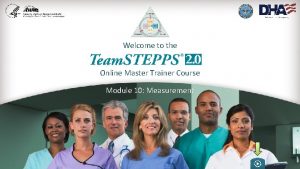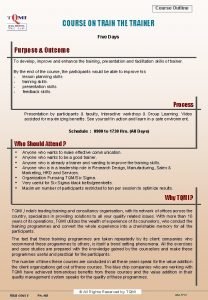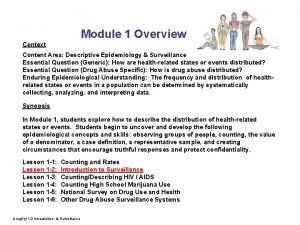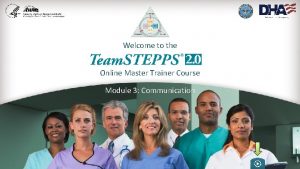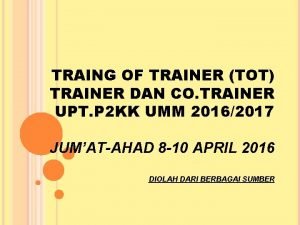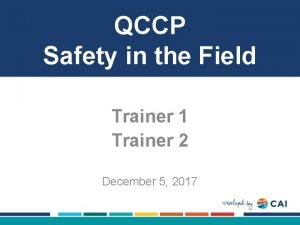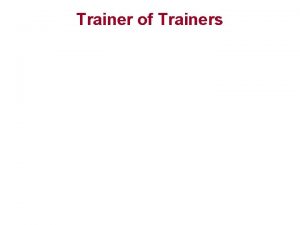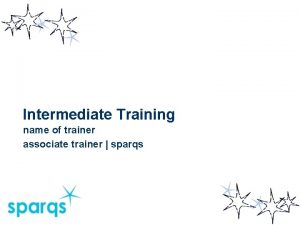Welcome to the Online Master Trainer Course Module










































- Slides: 42

Welcome to the Online Master Trainer Course Module 5: Situation Monitoring

How This Online Course Works This online course will walk you through the Team. STEPPS content just as you will present it when you train your colleagues and staff It teaches you all the concepts that comprise the Team. STEPPS initiative While also teaching you to teach Team. STEPPS to your colleagues Use the navigation buttons in the lower right to work through the online modules Select here to move back to the previous slide Module 5: Situation Monitoring Select here to move to the next slide 2 of 42

The Materials You Will Use When you deliver your training you will use these materials: • Instructor Manual – Course Management Guide – Instructor guides – Course slides – Measurement tools • Customizable materials • Videos Module 5: Situation Monitoring Select here to review materials on the Team. STEPPS website 3 of 42

Please Print the Instructor Guide To best use this online module, please print the Module 5 Instructor Guide, located here Read pages 3 -4 in the guide before we begin Then we will proceed to work through the slides you will use to train – just as if you are delivering this module at your facility Module 5: Situation Monitoring 4 of 42

Slide 2: Teamwork Exercise #2 Remember the paper chain teamwork exercise from Module 1? When you are teaching slide 2, you will ask the learners to get back into their teams, and this time identify a team leader Please proceed to the next slide to watch a video to observe how this activity works in the classroom Module 5: Situation Monitoring 5 of 42

Watch an Example of Teamwork Exercise #2 Select the image to launch a web browser where you can watch the video Module 5: Situation Monitoring 6 of 42

Slide 2: Debriefing Teamwork Exercise #2 Think about and answer the following: • What did the leader do before the exercise began? • Did it appear there was a clear plan? • Did it appear team members had a clear understanding of their roles and responsibilities? • Did it appear that team members knew the roles and responsibilities of others on their team? • Did you notice roles changing during the exercise? • What types of communication techniques were used? • What were team members monitoring throughout the task? • If you were a member of this team, what would you do differently? Module 5: Situation Monitoring 7 of 42

Slide 2: Facilitating the Exercise Refer to pages 5 and 6 in the Instructor Guide for the instructions Privately provide the leaders with the detailed instructions You will let the teams know they have 30 seconds to brief At the end of the 2 minutes, tell the teams to stop and identify the longest chain Conclude the exercise with a discussion of the questions Module 5: Situation Monitoring 8 of 42

Slide 3: Objectives Once you complete the exercise, you will use slide 3 to introduce the objectives for this module See page 7 in the Instructor Guide for details on how to facilitate this slide Module 5: Situation Monitoring 9 of 42

The Team. STEPPS Framework So far, we have covered: • Team Structure • Communication • Leadership In this module, we will cover Situation Monitoring Module 5: Situation Monitoring 10 of 42

Slide 4: Situation Monitoring: • A way for team members to be aware of what is going on around them • Is moderated by communication • Is enhanced by team leadership • Allows for mutual support by anticipating other team members’ needs Module 5: Situation Monitoring 11 of 42

A Continuous Process (Slide 5) Situation Monitoring (Individual Skill) Situation Awareness (Individual Outcome) Shared Mental Model (Team Outcome) Module 5: Situation Monitoring 12 of 42

The STEP Mnemonic (Slide 6) Components of Situation Monitoring Module 5: Situation Monitoring 13 of 42

Status of the Patient • • • Module 5: Situation Monitoring Patient History Vital Signs Medications Physical Exam Plan of Care Psychosocial Condition 14 of 42

Status of the Patient: Video Example Let’s view a video example of the first STEP element After you view the video, please return to the this browser window to continue this module Select the image to launch a web browser where you can watch the video Module 5: Situation Monitoring 15 of 42

Status of the Patient: Video Discussion Why did Greg have reason for concern? • Patient was not lucid • Patient did not “seem” herself • Patient’s stress level was elevated When you teach, ask participants the same question to generate discussion Module 5: Situation Monitoring 16 of 42

Team Members • • • Module 5: Situation Monitoring Fatigue Workload Task Performance Skill Level Stress Level 17 of 42

Team Members: Video Example Let’s view a video example of the “Team Members” element of STEP After you view the video, please return to the this browser window to continue this module Select the image to launch a web browser where you can watch the video Module 5: Situation Monitoring 18 of 42

Team Members: Video Discussion What did Dr. Pham do in this scenario? • Actively listened and participated in the care plan • Detected and corrected an error • Offered support in the form of clarification and correction When you teach, ask participants the same question to generate discussion Module 5: Situation Monitoring 19 of 42

I’M SAFE Checklist I = Illness M = Medication S = Stress A = Alcohol and Drugs F = Fatigue E = Eating and Elimination Module 5: Situation Monitoring 20 of 42

Slide 9: I’M SAFE Checklist Take 10 minutes to answer the following questions: • Would you feel able to express that you're not safe? • What are the factors that inhibit you from speaking up? • If you feel inhibited, what can you and your team do to change the culture? When you teach, ask participants these same questions Module 5: Situation Monitoring 21 of 42

Environment • • • Module 5: Situation Monitoring Facility Information Administrative Information Human Resources Triage Acuity Equipment 22 of 42

Progress Toward Goal Call a Huddle! Status of Team’s Patient(s) Goal of Team Tasks/Actions That Are or Need To Be Completed • Plan Still Appropriate • • Module 5: Situation Monitoring 23 of 42

Situation Monitoring Exercise A patient in the ICU has coded, and CPR is in progress. The Resuscitation Team is busy ensuring that IV access is available and the ET tube is inserted correctly. Dr. Matthews, the Team Leader, is calling out orders for drugs, X-rays, and labs. Judy, a nurse at the bedside, is inserting an IV. Nancy, another nurse, is drawing up meds. Judy can tell by Nancy’s expression that she didn’t get the last order called out by Dr. Matthews. Judy calls out while continuing to place the IV, “Nancy, he wants the high-dose epinephrine from the vial in the top drawer. ” Module 5: Situation Monitoring 24 of 42

Situation Monitoring Exercise: Discussion When you teach, ask your learners to discuss these questions: • What Team. STEPPS tools and strategies were exhibited in this scenario? • Identify each component of the STEP framework in this scenario. How was the STEP framework useful? For more information on facilitating this exercise, see page 16 in the Instructor Guide Module 5: Situation Monitoring 25 of 42

Situation Awareness is… The state of knowing the current conditions affecting one’s work Includes knowing… • Status of the patient • Status of other team members • Environmental conditions • Current progress toward the goal Module 5: Situation Monitoring 26 of 42

Conditions That Undermine Situation Awareness Failure to: • • • Share information with the team Request information from others Direct information to specific team members Include patient or family in communication Utilize resources fully (e. g. , status board, automation) Maintain documentation Know and understand where to focus attention Know and understand the plan Inform team members the plan has changed Module 5: Situation Monitoring 27 of 42

A Shared Mental Model is… The perception of, understanding of, or knowledge about a situation or process that is shared among team members through communication Module 5: Situation Monitoring 28 of 42

Sustaining Shared Mental Models (Slide 15) Shared mental models are sustained by: • Huddles • Briefings • Monitoring • Communication Please see page 19 in the Instructor Guide for more information on facilitating the discussion for slide 15 Module 5: Situation Monitoring 29 of 42

Shared Mental Model? Module 5: Situation Monitoring 30 of 42

How and When to Share? When: How: • Briefs • SBAR • Huddles • Call-outs • Debriefs • Check-backs • Transitions in Care Module 5: Situation Monitoring 31 of 42

Shared Mental Model: Practical Exercise Room # 1 Patient Jackson Orders VS EKG, O 2, Cardiac Enzymes HR 115 R 24 B/P 174/98 2 Simmons CBC, UA, HCG, IV HR 132 R 22 B/P 92/76 3 Bailey CXR, neb Rx, CBC, UA, O 2 HR 120 R 32 B/P 132/86 Write down your priority order and then go to the next slide Module 5: Situation Monitoring 32 of 42

Shared Mental Model: Practical Exercise Room # 1 Patient Jackson Orders VS EKG, O 2, Cardiac Enzymes HR 115 R 24 B/P 174/98 2 Simmons CBC, UA, HCG, IV HR 132 R 22 B/P 92/76 3 Bailey CXR, neb Rx, CBC, UA, O 2 HR 120 R 32 B/P 132/86 1. Patient Jackson is a 23 -year-old male. 2. Patient Simmons is a 19 -year-old female. 3. Patient Bailey is a 76 -year-old male. Revise your priority order and then go to the next slide Module 5: Situation Monitoring 33 of 42

Shared Mental Model: Practical Exercise Room # 1 Patient Jackson Orders VS EKG, O 2, Cardiac Enzymes HR 115 R 24 B/P 174/98 2 Simmons CBC, UA, HCG, IV HR 132 R 22 B/P 92/76 3 Bailey CXR, neb Rx, CBC, UA, O 2 HR 120 R 32 B/P 132/86 1. Patient Jackson is a known cocaine user with chest pain, and you are concerned about a possible MI. 2. Patient Simmons is hypotensive and experiencing tachycardia, and you are concerned about a ruptured ectopic pregnancy. 3. Patient Bailey has tachypnea, tachycardia, and fever, and you are concerned about pneumonia. 1. Patient Jackson is a 23 -year-old male. 2. Patient Simmons is a 19 -year-old female. 3. Patient Bailey is a 76 -year-old male. Would your priority ordering change? Module 5: Situation Monitoring 34 of 42

Slide 18: Practical Exercise When you facilitate the exercise, you can alter the information and exercise to best fit your situation Please review pages 22 and 23 in the Instructor Guide for more information on how to facilitate this exercise Module 5: Situation Monitoring 35 of 42

What Do You See? Take five minutes to write down the two images you find in each sketch Module 5: Situation Monitoring 36 of 42

What Do You See? Were you able find the two images in each sketch? Native American or Alaska Native Duck or Rabbit Old Lady or Young Woman Refer to page 24 in the instructor guide for more information Module 5: Situation Monitoring 37 of 42

How Shared Mental Models Help Teams Shared mental models can help teams by: • Leading to a mutual understanding of problems, goals, team strategies, patients’ conditions, and plans of care • Leading to more effective communication to ensure that team members have the necessary information for task performance • Enabling team members to back up and fill in for each other • Helping team members understand each other’s roles and how they interplay • Improving the ability of individual team members to provide mutual support by predicting and anticipating the needs of the team • Creating commonality of effort and purpose Module 5: Situation Monitoring 38 of 42

Tools & Strategies Summary BARRIERS Inconsistency in Team Membership Lack of Time Lack of Information Sharing Hierarchy Defensiveness Conventional Thinking Complacency Varying Communication Styles Conflict Lack of Coordination and Follow-up With Coworkers Distractions Fatigue Workload Misinterpretation of Cues Lack of Role Clarity Module 5: Situation Monitoring TOOLS and STRATEGIES Communication • • SBAR Call-Out Check-Back Handoff Leading Teams • Brief • Huddle • Debrief Situation Monitoring • I’M SAFE • STEP OUTCOMES n Shared Mental Model n Adaptability n Team Orientation n Mutual Trust n Team Performance n Patient Safety!! 39 of 42

Slide 22: Applying Team. STEPPS Exercise Take 15 minutes to answer these questions: • Do the team or individuals targeted for your Team. STEPPS implementation have an issue related to their ability to monitor the situation? • If so, which of the Situation Monitoring tools or strategies might you use to address the issue? Select here to download and print the Team. STEPPS Implementation Worksheet and answer the questions. Module 5: Situation Monitoring 40 of 42

Module 5 Summary In this module you learned to: • Discuss how situation monitoring affects team processes and outcomes • List components of the STEP mnemonic • Explain situation awareness and identify undermining conditions • Define a shared mental model and how it is cultivated within a team Module 5: Situation Monitoring 41 of 42

Module 5 Conclusion This concludes Module 5 of the Team. STEPPS Online Master Trainer Course Go to Module 6 Module 5: Situation Monitoring 42 of 42
 Teamstepps master trainer
Teamstepps master trainer Master trainer 45
Master trainer 45 Train the trainer objectives
Train the trainer objectives Train the trainer course outline
Train the trainer course outline C device module module 1
C device module module 1 Supervisor safety leadership training
Supervisor safety leadership training Course module sample
Course module sample Welcome welcome this is our christmas story
Welcome welcome this is our christmas story My dear students
My dear students Disadvantages of cavity wall
Disadvantages of cavity wall Course title and course number
Course title and course number Course interne course externe
Course interne course externe Welcome to city guesser
Welcome to city guesser Welcome to access online
Welcome to access online Welcome to my online class
Welcome to my online class Ciphers
Ciphers Oklahoma supplemental online course program
Oklahoma supplemental online course program Ipac administrative controls answers
Ipac administrative controls answers Online cryptography course
Online cryptography course Jrotc marksmanship instructor course online
Jrotc marksmanship instructor course online Ptit safe driving and awareness course online
Ptit safe driving and awareness course online Nbome soap note example
Nbome soap note example Medical english online course
Medical english online course Fmcsa north american standard level i course online
Fmcsa north american standard level i course online Jrotc marksmanship instructor course online
Jrotc marksmanship instructor course online Internetmultimedia org live stream
Internetmultimedia org live stream Gigaplex academy
Gigaplex academy American beauty online
American beauty online Hình ảnh bộ gõ cơ thể búng tay
Hình ảnh bộ gõ cơ thể búng tay Slidetodoc
Slidetodoc Bổ thể
Bổ thể Tỉ lệ cơ thể trẻ em
Tỉ lệ cơ thể trẻ em Gấu đi như thế nào
Gấu đi như thế nào Chụp tư thế worms-breton
Chụp tư thế worms-breton Alleluia hat len nguoi oi
Alleluia hat len nguoi oi Môn thể thao bắt đầu bằng chữ đua
Môn thể thao bắt đầu bằng chữ đua Thế nào là hệ số cao nhất
Thế nào là hệ số cao nhất Các châu lục và đại dương trên thế giới
Các châu lục và đại dương trên thế giới Cong thức tính động năng
Cong thức tính động năng Trời xanh đây là của chúng ta thể thơ
Trời xanh đây là của chúng ta thể thơ Cách giải mật thư tọa độ
Cách giải mật thư tọa độ 101012 bằng
101012 bằng độ dài liên kết
độ dài liên kết
